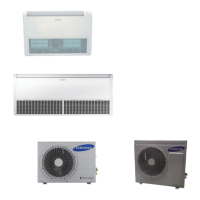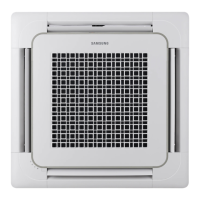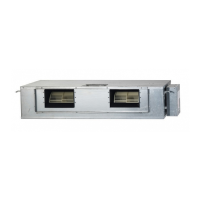A Supplier's name -
Samsung
Electronics Co., Ltd.
Samsung
Electronics Co., Ltd.
Samsung
Electronics Co., Ltd.
B Model name (Indoor/Outdoor) -
AC052HBMDKH
AC052HCADKH
AC060HBMDKH
AC060HCADKH
AC071HBMDKH
AC071HCADKH
C Sound Power Level (Inside/Outside) dB(A) 53/63 57/64 57/65
D Refrigerant name
1)
- R-410A R-410A R-410A
E GWP - 2088 2088 2088
F SEER 6,1 6,1 5,9
G Energy eciency class (SEER) - A++ A++ A+
H Q
CE
2)
(cooling season) kWh/a 287 344 421
I Pdesignc kW 5,0 6,0 7,1
J SCOP - 3,8 4,0 4,0
K Energy eciency class (SCOP) - A A+ A+
L Q
HE
3)
(heating season) kWh/a 1326 1680 1680
M Other heating seasons suitable for use -
-
ⅳ)
-
ⅳ)
-
ⅳ)
N Pdesignh (Average) kW 3,6 4,8 4,8
O Back up heating capacity (Average) kW 0 0 0
P Declared capacity (Average) kW 3,6 4,8 4,8
Q Pdesignh (Warmer) kW - - -
R Back up heating capacity (Warmer) kW - - -
S Declared capacity (Warmer) kW - - -
T Pdesignh (Colder) kW - - -
U Back up heating capacity (Colder) kW - - -
V Declared capacity (Colder) kW - - -
1. Refrigerant leakage contributes to climate change. Refrigerant with lower global warming potential (GWP)
would contribute less to global warming than a refrigerant with higher GWP, if leaked to the atmosphere. This
appliance contains a refrigerant uid with a GWP equal to [2088].
This means that if 1 kg of this refrigerant uid would be leaked to the atmosphere, the impact on global
warming would be [2088] times higher than 1 kg of CO
2
, over a period of 100 years.
Never try to interfere with the refrigerant circuit yourself or disassemble the product yourself and always ask a
professional.
2. Energy consumption “XYZ” kWh per year, based on standard test results.
Actual energy consumption will depend on how the appliance is used and where it is located.
3. Energy consumption “XYZ” kWh per year, based on standard test results.
Actual energy consumption will depend on how the appliance is used and where it is located.
ⅳ. Warmer / Colder / Warmer & Colder

